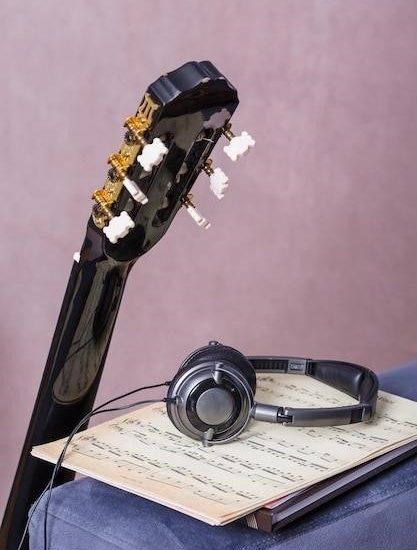Singer 2277 Sewing Machine Manual
This comprehensive guide will help you understand and utilize all the features of your Singer 2277 sewing machine‚ from setting it up to troubleshooting common issues.
Introduction
The Singer 2277 Tradition Sewing Machine is a versatile and user-friendly machine designed for both beginners and experienced sewers. This manual serves as your guide to understanding and utilizing the full potential of your Singer 2277. It covers everything from setting up the machine to mastering its various features and troubleshooting common issues. Whether you’re a seasoned sewist or just starting your sewing journey‚ this manual will help you navigate the world of sewing with confidence and ease.
Overview of the Singer 2277
The Singer 2277 Tradition Sewing Machine is a reliable and affordable option for both beginners and intermediate sewers. It features a range of stitches‚ including basic‚ decorative‚ and stretch stitches‚ making it suitable for a variety of projects. The machine boasts an automatic needle threader‚ a free arm for extra mobility‚ and a built-in needle threader for added convenience. The Singer 2277 also includes a heavy-duty metal frame‚ ensuring durability and stability during your sewing endeavors.
Key Features of the Singer 2277
The Singer 2277 is packed with features designed to make your sewing experience smoother and more enjoyable. It boasts an impressive 97 stitch applications‚ offering versatility for various projects. The machine also features adjustable stitch width‚ allowing you to customize your stitches to achieve the desired look for your fabric. Its free arm design provides extra mobility when working on smaller projects like sleeves or pant legs. The Singer 2277 also includes a built-in needle threader‚ making threading a breeze and saving you time and effort.
Stitch Options
The Singer 2277 offers a wide range of stitch options‚ catering to both beginners and experienced sewers. These stitches include basic stitches for everyday sewing‚ such as straight stitch‚ zigzag stitch‚ and buttonhole stitch. It also includes decorative stitches for adding a touch of flair to your projects‚ such as satin stitch‚ blanket stitch‚ and scallop stitch. The machine’s stretch stitches are ideal for working with stretchy fabrics like knitwear and Lycra‚ ensuring a professional finish. The Singer 2277 provides the tools you need to create a diverse range of projects‚ from simple repairs to intricate garments.
Automatic Needle Threader
The Singer 2277 features an automatic needle threader‚ a convenient feature that simplifies the threading process‚ especially for those with less experienced hands. This built-in tool guides the thread through the needle’s eye with ease‚ eliminating the frustration and potential eye strain often associated with manual threading. The automatic needle threader is a valuable asset‚ allowing you to focus on your sewing project without getting bogged down by the intricacies of threading. This feature contributes to a smoother and more enjoyable sewing experience‚ making the Singer 2277 an excellent choice for both beginners and seasoned sewers.
Free Arm for Extra Mobility
The Singer 2277 boasts a free arm‚ a versatile feature that enhances its usability for various sewing tasks. This feature allows you to easily maneuver the machine around cylindrical items like sleeves‚ pant legs‚ or cuffs‚ providing greater flexibility and precision when working with these challenging areas. The free arm essentially transforms the machine into a smaller‚ more agile unit‚ allowing you to sew intricate curves and tight spaces with ease. This design element proves particularly helpful for tailoring garments‚ crafting home decor‚ or tackling other projects involving circular shapes. The free arm feature makes the Singer 2277 a highly functional and adaptable sewing machine‚ accommodating a wide range of sewing needs.
Built-in Needle Threader
The Singer 2277 features a convenient built-in needle threader‚ a time-saving and user-friendly addition that simplifies the threading process. This automated feature eliminates the need for manual threading‚ which can often be a frustrating and time-consuming task‚ particularly for individuals with limited dexterity or vision. By simply engaging the built-in needle threader‚ the machine effortlessly guides the thread through the needle’s eye‚ ensuring a smooth and efficient threading experience. This feature is particularly beneficial for beginners or those who find manual threading challenging. The built-in needle threader contributes to a more enjoyable and efficient sewing experience‚ allowing you to focus on your creativity and project without being hindered by tedious threading processes.
Adjustable Stitch Width
The Singer 2277 sewing machine offers adjustable stitch width‚ allowing you to tailor your stitches to suit your specific sewing needs and projects. This feature enables you to create a wide range of stitch patterns‚ from narrow stitches for precise seams to wider stitches for decorative purposes. The adjustable stitch width control‚ typically located on the machine’s front panel‚ allows you to easily adjust the stitch width by turning a dial or knob. This flexibility is crucial for achieving professional-looking results and creating unique designs. Whether you’re sewing delicate fabrics‚ sturdy materials‚ or adding decorative embellishments‚ the adjustable stitch width feature provides the versatility to adapt to your creative vision.
Heavy-Duty Metal Frame
The Singer 2277 sewing machine boasts a sturdy and durable heavy-duty metal frame‚ providing a solid foundation for smooth and reliable sewing. This robust construction ensures that the machine remains stable even during demanding sewing tasks‚ preventing vibrations and ensuring precise stitch formation. The metal frame also contributes to the overall longevity of the machine‚ making it a reliable companion for years to come. The Singer 2277’s heavy-duty metal frame is a testament to its commitment to quality and durability‚ giving you confidence in its ability to handle a wide range of sewing projects with ease.
Using the Singer 2277
Once you’ve unpacked your Singer 2277 sewing machine and familiarized yourself with its features‚ it’s time to put it to work. This section will guide you through the process of setting up your machine‚ threading it correctly‚ winding the bobbin‚ changing the needle‚ adjusting tension‚ and selecting stitch patterns. From there‚ you’ll be ready to start sewing with confidence‚ creating beautiful projects with ease. The user-friendly design and intuitive controls of the Singer 2277 make it a joy to use‚ whether you’re a seasoned sewer or just starting out.
Setting Up the Machine
Before you start sewing‚ it’s essential to properly set up your Singer 2277 sewing machine. Begin by placing the machine on a stable‚ flat surface. Ensure that the power cord is securely plugged into a working electrical outlet. Next‚ lift the presser foot lever to raise the presser foot. Now‚ you can thread the machine by following the instructions in the manual. Finally‚ wind the bobbin with the appropriate thread‚ using the bobbin winding mechanism on your machine. You are now ready to begin your sewing journey with the Singer 2277!
Threading the Machine
Threading the Singer 2277 is a straightforward process. Begin by placing the thread spool on the spool pin. Thread the thread through the thread guide located on the top of the machine. Next‚ guide the thread through the tension discs‚ ensuring it sits in the grooves. Continue threading the thread through the take-up lever‚ then through the needle clamp. Finally‚ thread the needle from front to back‚ ensuring the thread goes through the needle eye. Pull the thread gently to ensure it is threaded correctly. You can then lower the presser foot lever to hold the thread in place. By following these simple steps‚ you can easily thread your Singer 2277 and get ready to sew.
Winding the Bobbin
Winding a bobbin for your Singer 2277 is essential for smooth sewing. Start by placing a bobbin on the bobbin winder spindle. Thread the bobbin with the thread‚ ensuring it goes through the small hole on the bobbin. Next‚ gently pull the thread through the guide on the bobbin winder and then around the tension disc. Hold the thread end firmly and press the bobbin winder button to start the winding process. As the bobbin spins‚ the thread will wind onto the bobbin. When the bobbin is full‚ the winder will automatically stop. Carefully remove the bobbin from the winder and cut the thread. You can now insert the wound bobbin into the bobbin case and begin sewing. This simple process ensures that your Singer 2277 has a fresh bobbin ready for any sewing project.
Changing the Needle
Changing the needle on your Singer 2277 is a simple process that ensures smooth sewing. First‚ raise the needle to its highest position. This can be done by turning the handwheel towards you until the needle is at its peak. Next‚ loosen the needle clamp screw by turning it counter-clockwise. Carefully remove the old needle from the needle clamp. When inserting the new needle‚ make sure the flat side of the needle faces the back of the machine. Slide the needle into the needle clamp and tighten the screw by turning it clockwise. Make sure the needle is securely fastened. Lower the needle to its lowest position by turning the handwheel. You can now check if the needle is properly installed by gently moving the needle up and down to ensure it moves freely. With the new needle in place‚ your Singer 2277 is ready to sew with ease.
Adjusting Tension
Proper thread tension is crucial for achieving neat and consistent stitches. The Singer 2277 features a tension dial located on the front of the machine‚ allowing you to adjust the tension according to your fabric and desired stitch quality. To increase tension‚ turn the dial clockwise‚ tightening the thread. Turning the dial counter-clockwise loosens the thread‚ decreasing tension. When adjusting the tension‚ it’s best to test it by sewing a sample seam on a scrap fabric. If the stitches are too loose‚ increase the tension. If they are too tight‚ decrease the tension. For a balanced tension‚ the top and bottom threads should intertwine evenly on the underside of the fabric. Experiment with different settings to find the optimal tension for your specific sewing needs.
Selecting Stitch Patterns
The Singer 2277 offers a wide variety of stitch patterns to suit your sewing needs. The stitch selection dial‚ located on the front of the machine‚ allows you to choose from various options‚ including basic stitches like straight stitch and zigzag stitch‚ decorative stitches for embellishment‚ and stretch stitches for working with elastic fabrics. The machine’s instruction manual provides a detailed guide to each stitch pattern‚ including its application and how to adjust its length and width. To select a stitch‚ simply rotate the stitch selection dial to the desired pattern. The machine will automatically adjust the needle position and stitch settings for the chosen pattern. Experiment with different stitches to discover the best options for your projects. Remember to refer to the manual for specific stitch descriptions and usage instructions.
Sewing with the Machine
Once your Singer 2277 is set up and threaded‚ you’re ready to begin sewing. Start by lowering the presser foot and placing your fabric under the needle. Use the foot pedal to control the sewing speed‚ adjusting it based on the type of fabric and your desired stitch length. Guide the fabric smoothly along the sewing line‚ ensuring it’s evenly fed into the machine. For straight stitching‚ use the straight stitch setting and guide the fabric along the edge of the presser foot. For zigzag stitching‚ adjust the stitch width and length to create the desired pattern. Remember to practice on scrap fabric before working on your final project. Experiment with different stitch patterns‚ tension settings‚ and sewing speeds to find the best combination for your specific needs. With practice‚ you’ll become proficient in using your Singer 2277 to create various sewing projects.

Troubleshooting
While the Singer 2277 is generally reliable‚ you may encounter some issues during use. If your machine starts skipping stitches‚ check the needle for damage or improper insertion. Ensure the bobbin is properly wound and inserted. Adjust the thread tension if needed‚ as this can affect stitch quality. If the machine is making excessive noise‚ check for loose screws or parts. Clean and lubricate the machine regularly according to the manual’s instructions. If you’re experiencing problems with thread breakage‚ ensure you’re using the correct needle type and size for the fabric. Make sure the needle is securely inserted and not bent. If you’re having trouble with the automatic needle threader‚ check if the thread is properly threaded through the guide and tension discs. If you’re unable to resolve the issue‚ consult the manual for further troubleshooting steps or contact Singer customer service for assistance.
Frequently Asked Questions
Many Singer 2277 owners have questions about the machine’s features and functionality. A common question is about needle breakage. This can be caused by using the wrong needle for the fabric‚ having the needle set too low‚ improper fabric guidance‚ or incorrect bobbin case insertion. Another frequent concern is thread tension issues. Ensure the thread is correctly threaded through all guides and tension discs‚ and that the spool is positioned properly. You can also adjust the tension dial on the machine. Changing presser feet is straightforward; raise the presser foot lever‚ press the release button‚ and align the new foot with the slot before lowering the lever; Excessive noise may be due to loose screws or parts‚ so check and tighten as needed. Regular cleaning and lubrication are essential to prevent noise. Finally‚ many users ask about manual availability. The Singer 2277 manual is available online in English‚ French‚ and Spanish. If you have any other questions‚ consult the manual or contact Singer customer service.
Needle Breakage
Needle breakage is a common issue with sewing machines‚ and the Singer 2277 is no exception. Several factors can contribute to this problem‚ including using the wrong needle size or type for the fabric. It is crucial to select a needle that is compatible with the thickness of your fabric. Another cause is improper needle insertion. Make sure the needle is securely fastened in the needle clamp and positioned correctly. A loose needle can cause it to bend or break during sewing. Also‚ ensure the fabric is properly guided through the machine. Too much pressure or uneven feeding can strain the needle. Finally‚ check if the bobbin case is correctly inserted. If the bobbin case is not properly seated‚ it can cause the needle to hit it during sewing‚ leading to breakage.
Thread Tension Issues
Thread tension problems are a common complaint among sewing machine users‚ and the Singer 2277 is no exception. Uneven thread tension can result in puckering‚ skipped stitches‚ or loose threads. Several factors can contribute to these issues. First‚ ensure the thread is properly threaded through all the necessary guides‚ tension discs‚ and the needle. A tangled or incorrectly threaded thread can cause tension inconsistencies. Second‚ the thread spool needs to be positioned correctly. A tilted or improperly placed spool can affect thread tension. Third‚ the thread tension may require adjustment. The tension control dial on the front panel allows you to increase tension for tighter stitches or decrease it for looser stitches. Finally‚ make sure the bobbin is correctly wound and inserted. An improperly wound or inserted bobbin can also cause thread tension issues. By addressing these potential causes‚ you can achieve balanced thread tension and produce high-quality stitches.
Changing Presser Feet
The Singer 2277 comes equipped with various presser feet designed for different sewing tasks. Changing presser feet is a simple process that allows you to adapt your machine to a wide range of projects. To change a presser foot‚ first‚ raise the presser foot lever to lift the foot; Then‚ press the release button located at the back of the presser foot to detach it. Align the new presser foot with the slot on the machine and lower the presser foot lever to secure it in place. The presser foot will now be ready for your chosen sewing task. From basic stitching to decorative embroidery‚ the ability to change presser feet adds versatility and precision to your sewing projects‚ allowing you to achieve professional-looking results.
Excessive Noise
If your Singer 2277 sewing machine is producing excessive noise‚ it’s important to address the issue promptly to prevent further damage. Several factors can contribute to excessive noise‚ including a lack of lubrication‚ loose screws or parts‚ or a build-up of lint and debris. First‚ ensure the machine is placed on a stable and level surface to minimize vibrations. Then‚ check for any loose screws or parts that may need tightening. Regularly cleaning and oiling the machine according to the manual’s instructions can also help prevent excessive noise. If you’ve addressed these points and the noise persists‚ it’s best to consult a qualified sewing machine technician for further diagnosis and repair.
Manual Availability
The Singer Tradition 2277 sewing machine manual is readily available in English‚ French‚ and Spanish. You can find the manual online through various resources‚ including Manuals.co.uk‚ Amazon‚ and dedicated sewing machine websites. Additionally‚ you can often download a free PDF version of the manual directly from the manufacturer’s website. The manual provides detailed instructions on setting up‚ threading‚ winding bobbins‚ changing needles‚ adjusting tension‚ selecting stitch patterns‚ and troubleshooting common issues. It’s essential to refer to the manual for guidance on proper operation and maintenance of your Singer 2277 sewing machine.
Where to Find the Singer 2277 Manual
Finding a copy of the Singer 2277 sewing machine manual is quite straightforward. You can access it through various online resources. Websites like Manuals.co.uk and Amazon offer comprehensive collections of user manuals for a wide range of products‚ including sewing machines. These platforms allow you to search for the manual by model number‚ brand‚ or product type. Additionally‚ you can find the manual on dedicated sewing machine websites or directly from the manufacturer’s website. The manual will provide detailed instructions on how to operate and maintain your Singer 2277 sewing machine‚ ensuring a smooth and enjoyable sewing experience.
Online Resources
The internet is a treasure trove of information‚ including user manuals for various products. If you’re looking for the Singer 2277 manual‚ several online resources can help you find it. Websites like Manuals.co.uk specialize in providing downloadable user manuals for a vast array of brands and models. You can simply search for the Singer 2277 manual using the model number or product name. Additionally‚ websites like Amazon often host user manuals for products sold on their platform. Searching for the Singer 2277 manual on Amazon can lead you to a downloadable PDF version. Remember to check the manufacturer’s website‚ Singer.com‚ as they may also have a downloadable version of the manual available for their customers.





